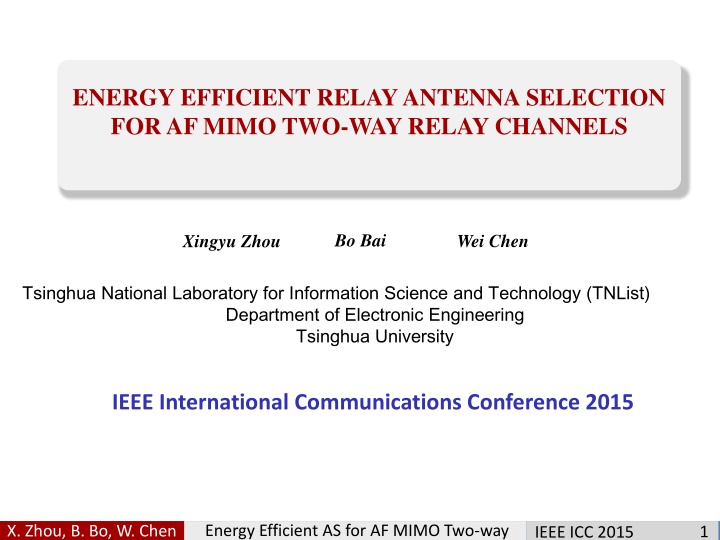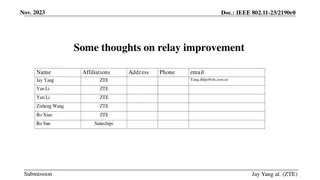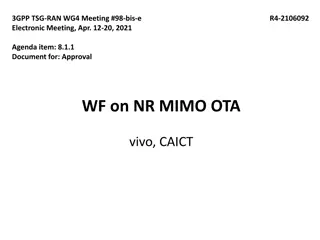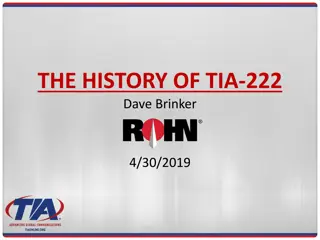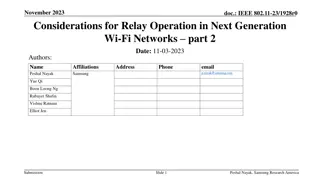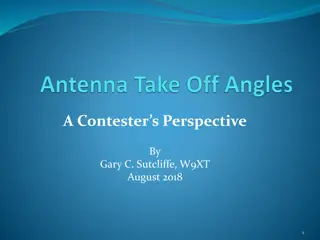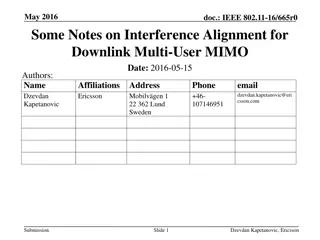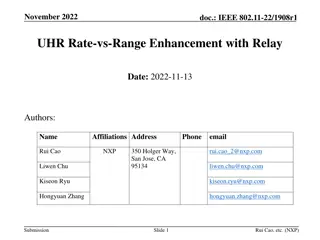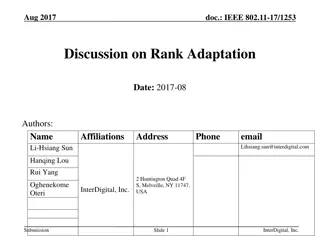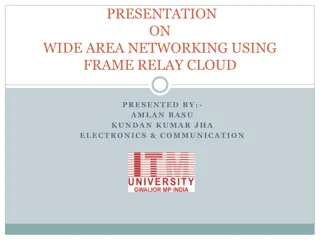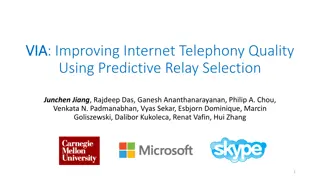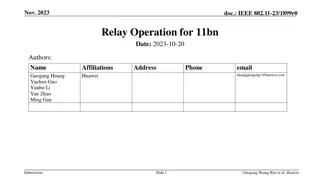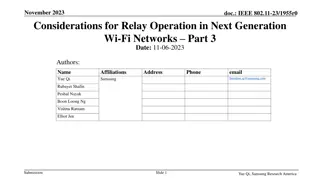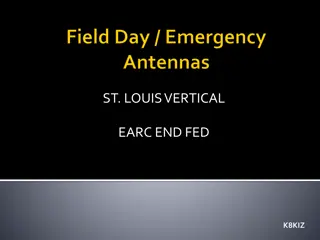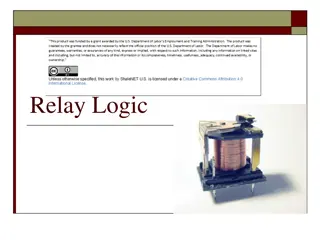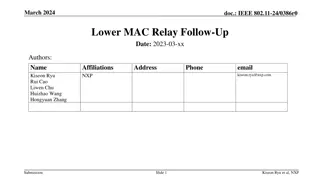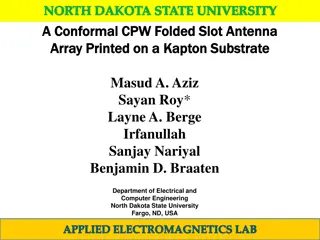Energy Efficient Relay Antenna Selection for AF MIMO Two-Way Relay Channels
The study explores energy-efficient relay antenna selection for AF MIMO two-way relay channels, aiming to optimize energy efficiency while maintaining performance. It discusses the advantages and disadvantages of two-way MIMO relay systems, emphasizing higher spectral efficiency, improved reliability, better coverage, alongside challenges like costly multiple RF chains and high complexity. Different methods and models for energy-efficient MIMO with antenna selection are analyzed, with a focus on optimizing energy efficiency in relay communications. Various research findings and approaches presented at the IEEE International Communications Conference shed light on promising strategies for enhancing energy efficiency in wireless relay systems.
Download Presentation

Please find below an Image/Link to download the presentation.
The content on the website is provided AS IS for your information and personal use only. It may not be sold, licensed, or shared on other websites without obtaining consent from the author.If you encounter any issues during the download, it is possible that the publisher has removed the file from their server.
You are allowed to download the files provided on this website for personal or commercial use, subject to the condition that they are used lawfully. All files are the property of their respective owners.
The content on the website is provided AS IS for your information and personal use only. It may not be sold, licensed, or shared on other websites without obtaining consent from the author.
E N D
Presentation Transcript
ENERGY EFFICIENT RELAY ANTENNA SELECTION FOR AF MIMO TWO-WAY RELAY CHANNELS Bo Bai Wei Chen Xingyu Zhou Is there a promising way? Is there a promising way? Tsinghua National Laboratory for Information Science and Technology (TNList) Department of Electronic Engineering Tsinghua University IEEE International Communications Conference 2015 Energy Efficient AS for AF MIMO Two-way X. Zhou, B. Bo, W. Chen 1 IEEE ICC 2015
OUTLINE Background & Problem Formulation An iterative approach Simulation results Conclusions Energy Efficient AS for AF MIMO Two-way X. Zhou, B. Bo, W. Chen IEEE ICC 2015 2
OUTLINE Background & Problem Formulation An iterative approach Simulation results Conclusions Energy Efficient AS for AF MIMO Two-way X. Zhou, B. Bo, W. Chen IEEE ICC 2015 3
TWO-WAY MIMO RELAY Is there a promising way? Is there a promising way? Advantages & Disadvantages Higher spectral efficiency Improved reliability Better coverage Costly multiple RF chains High complexity of SP Especially on the relay Energy Efficient AS for AF MIMO Two-way X. Zhou, B. Bo, W. Chen IEEE ICC 2015 4
ANTENNA SELECTION (AS) RF RF RF RF RF Received Received Transmitted Transmitted Amplify and Forward RF AS AS Energy efficient MIMO with AS? Energy efficient MIMO with AS? Signal Signal Signal Signal RF RF RF Suboptimal Methods Limitations of Suboptimal Methods Energy Efficient MIMO H.Park 12 Number of RF chains is given and fixed. NOT Energy Efficient. NOT Energy Efficient. Holistic power model. [S. Cui 04] Urgent and Important. Features Low Complexity Optimal Method J.-C Chen 12 Only Transmission power is considered Exhaustive Search Near-Optimal Complexity Prohibitive Capacity maximization only. Energy efficiency maximization. [D. Feng 13] =C EE P Energy Efficient AS for AF MIMO Two-way J.Leithon 12 Definition: IEEE ICC 2014 IEEE ICC 2015 X. Zhou, B. Bo, W. Chen 5
ENERGY EFFICIENT MIMO WITHAS RF RF RF RF RF Transmitted Transmitted Received Received Amplify and Forward MIMO? MIMO? RF AS AS SW Signal Signal Signal Signal Energy efficient AS for Two Energy efficient AS for Two- -way AF way AF RF RF RF Previous Work Previous Work Features Features X. Zhou ICC 14 : p2p MIMO Number of active RF chains is dynamical X. Zhou GlobalSIP14: one-way relay Optimization of RF and AS simultaneously EE maximization X. Zhou, B. Bo, W. Chen X. Zhou, B. Bo, W. Chen Energy Efficient AS for AF MIMO Two-way IEEE ICC 2015 6
PROBLEM FORMULATION How to solve it efficiently ? How to solve it efficiently ? Features Holistic power model Our problem Performance metric: Energy Efficient AS for AF MIMO Two-way X. Zhou, B. Bo, W. Chen X. Zhou, B. Bo, W. Chen IEEE ICC 2015 7
OUTLINE Background & Problem Formulation An iterative approach Simulation results Conclusions Energy Efficient AS for AF MIMO Two-way X. Zhou, B. Bo, W. Chen IEEE ICC 2015 8
CORE IDEA Our problem Proposed Algorithm Theorem 1 Theorem 1 Greedy Selection AS at the nth step * sP rP Optimize the power for the nth step EE Proposition 1 Fractional Programming t r Energy Efficient AS for AF MIMO Two-way X. Zhou, B. Bo, W. Chen IEEE ICC 2015 9
ANTENNA SELECTION PROCESS Theorem 1 With the relay antenna selection and given transmission power, the EE of AF MIMO TWRC under the holistic power model is given by the following iterative equation: EE increment when is selected ( , ) l s effect of circuit power where Main Idea of AS At each step, select the antenna pair at the relay that brings the largest contribution to the energy efficiency. It can be equivalent to this problem : ( , ) l s Energy Efficient AS for AF MIMO Two-way X. Zhou, B. Bo, W. Chen IEEE ICC 2015 10
POWER ADAPTATION Main Idea of PA Proposition 1 An optimization problem is pseudo-concave when is concave and is convex. It can be related to the following parametric problem The maximum value can be achieved if and only if and satisfy The root can be efficiently found by the Dinkelbach method. Main Idea of Power Adaptation Remark Transform a non-convex optimization problem into parametric convex optimization problem It can be solved with a superlinear convergence rate. Energy Efficient AS for AF MIMO Two-way X. Zhou, B. Bo, W. Chen IEEE ICC 2015 11
OUTLINE Background & Problem Formulation An iterative approach Simulation results Conclusions Energy Efficient AS for AF MIMO Two-way X. Zhou, B. Bo, W. Chen IEEE ICC 2015 12
SIMULATION RESULTS (1/3) Near-optimal Significant Gain Figure: Energy efficiency VS. the transmission distance Energy Efficient AS for AF MIMO Two-way X. Zhou, B. Bo, W. Chen IEEE ICC 2015 13
SIMULATION RESULTS (2/3) Figure: Optimal transmission power VS. the transmission distance. Energy Efficient AS for AF MIMO Two-way X. Zhou, B. Bo, W. Chen IEEE ICC 2015 14
SIMULATION RESULTS (3/3) Figure: Statistical results for the optimal number of active RF chains V.S. the distance when achieving the maximum EE Energy Efficient AS for AF MIMO Two-way X. Zhou, B. Bo, W. Chen IEEE ICC 2015 15
OUTLINE Background & Problem Formulation An iterative approach Simulation results Conclusions Energy Efficient AS for AF MIMO Two-way X. Zhou, B. Bo, W. Chen IEEE ICC 2015 16
CONCLUSIONS Our proposed iterative algorithm enjoys a low complexity and achieves the near-optimal performance in all transmission distances. Our algorithm is capable of simultaneously improving EE and reducing the transmission power. Our work helps to design future energy efficient wireless communication systems. Thank you very much! All comments are welcomed ;-) Energy Efficient AS for AF MIMO Two-way X. Zhou, B. Bo, W. Chen IEEE ICC 2015 17
